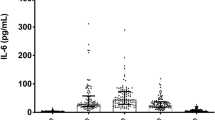Abstract
Introduction
Thanks to the development of defense mechanisms, the human body has been able to adapt to adverse environmental conditions causing acute and chronic stress. This adaptive response includes a specific group of proteins called heat shock proteins (Hsps).
Objective
The present study examines the biology of Hsps and other acute phase reactants in patients subjected to uncomplicated total knee arthroplasty as possible biomarkers of surgical inflammatory stress.
Material/methods
A prospective, observational descriptive pilot study with analytical components was carried out, evaluating the acute phase response levels of 20 patients diagnosed with advanced primary gonarthrosis before and after total knee arthroplasty.
Results
Statistically significant changes were recorded in leukocyte count, fibrinogen, erythrocyte sedimentation rate, C-reactive protein (CRP), IL-6, and anti-Hsp70i autoantibodies at the studied timepoints. Serum Hsp70i levels were lower in the immediate postoperative period, followed by recovery. In conclusion, despite a lack of diagnostic specificity, combined measurements of acute phase response levels can be useful in detecting the presence or intensity of systemic inflammatory processes. The circulating anti-Hsp70i values decreased significantly 24 h after surgery, a fact that may reflect immune depression secondary to surgical stress.


Similar content being viewed by others
References
Benson M, Wennergren G, Fransson M, Cardell L (2004) Altered levels of the soluble IL-1, IL-4 and TNF receptors, as well as the IL-1 receptor antagonist, in the intermittent allergic rhinitis. Int Arch Allergy Immunol 134:227–232
Boeri D, Dondero F, Storace D, Maiello M, Pasqualini M, Pellici R (2003) Heat-shock protein 70 favours human liver recovery from isquemia-reperfusion. Eur J Clin Investig 33:500–504
Chan YC, Shukla N, Abdus-Samee, Berwanger CS, Stansby G (1999) Anti-heat-shock protein 70 kDa antibodies in vascular patients. Eur J Vasc Endovasc Surg 18:381–385
De Maio A (1999) Heat shock proteins: facts, thoughts, and dreams. Shock 11:1–12
DeMeester SL, Buchman TG, Cobb JP (2001) The heat shock paradox: does NF-kB determine cell fate? FASEB J 15:270–274
Ellis RJ, van der Vies SM (1991) Molecular chaperones. Annu Rev Biochem 60:321–347
Feige U, van Eden W (1996) Infection, autoimmunity and autoimmune disease. In: Feige U, Morimoto RI, Yahara I, Polla BS (eds) Stress-inducible cellular responses. Birkhäuser, Basel, pp 359–373
Freitas I, Fernández-Somoza M, Essenfed-Sekler E, Cardier JE (2004) Serum levels of the apoptosis associated molecules, tumor necrosis factor-alpha, tumor necrosis factor type-I receptor and Fas/FasL, in sepsis. Chest 125:2238–2246
Fuller KJ, Issels RD, Slosman DO, Guillet JG, Soussi T, Polla BS (1994) Cancer and the heat shock response. Eur J Cancer 30:1884–1891
Greaves DR, Channon KM (2002) Inflammation and immune responses in atherosclerosis. Trends Immunol 23:535–541
Giannoudis PV, Smith MR, Evans RT, Bellamy MC, Guillou PJ (1998) Serum CPR and IL-6 after trauma. Not predictive of septic complications in 31 patients. Acta Orthop Scand 69:184–188
Ishihara K, Yamagishi N, Hatayama T (2004) Suppression of heat and polyglutamineinduced cytotoxicity by nonesteroidal anti-inflammatory drugs. Eur J Biochem 271:4552–4558
Kiang JG, Tsokos GC (1998) Heat shock protein 70 kDa: molecular biology, biochemistry, and physiology. Pharmacol Ther 80:183–201
Kitamura Y, Nomura Y (2003) Stress proteins and glial functions, possible therapeutic targets for neurodegenerative disorders. Pharmacol Ther 97:35–53
Lawrence JS, Bremner JM, Osteoarthrosis BF (1966) Prevalence in the population and relationship between symptoms and X-ray changes. Ann Rheum Dis 25:1–24
Lin J, Adams LG, Ficht TA (1992) Characterization of the heat shock response in Brucella abortus and isoation of genes encoding the GroE heat shock protein. Infect Immunol 60:2425–2431
Matzinger P (2002) The danger model: a renewed sense of self. Science 12(296):301–305
Mollinedo F, Borregaard N, Boxer LA (1999) Novel trends in neutrophil structure, function and development. Trends Immunol Today 20:535–537
Pannen BH, Maeda K, Ayuse T, Brienza N, Revelly JP, Robotham JL, Buchman TG (1995) Hepatic heat shock and acute-phase gene expression are induced simultaneously after celiotomy in the anesthetized pig. Anesthesiology 83:850–859
Pockley AG, Bulmer J, Hanks BM, Wright BH (1999) Identification of human heat shock protein 60 and anti-Hsp60 antibodies in the peripheral circulation of normal individuals. Cell Stress Chap 4:29–35
Pockley AG (2003) Heat shock proteins as regulators of the immune response. Lancet 362:469–476
Pockley AG (2002) Heat shock proteins, inflammation, and cardiovascular disease. Circulation 105:1012–1017
Polat C, Kahraman A, Yilmaz S, Koken T, Serteser M, Akbulut G, Arikan Y, Dilek ON, Gokce O (2003) A comparison of oxidative stress response and capacity of open and laparoscopic hernia repairs. J Laparoendosc Adv Surg Tech A 13:167–173
Ramos R (2008) Proteínas de choque térmico en estrés quirúrgico y anestésico. Thesis
Rittosa F (1962) A new puffing pattern induced by temperature shock and DNP in Drosophila. Experientia 18:571–573
Tissieres A, Mitchell HK, Tracy UM (1974) Protein synthesis in the salivary glands of Drosophila melanogaster: relation to chromosome puffs. J Mol Biol 84:389–398
Udelsman R, Blake MJ, Holbrook NJ (1991) Molecular response to surgical stress: specific and simultaneous heat shock protein induction in the adrenal cortex, aorta, and vena cava. Surgery 110:1125–1131
Voss MR, Stallone JN, Li M, Cornelussen RN, Knuefermann P, Knowlton AA (2003) Gender differences in the expression of heat shock proteins: the effect of estrogen. Am J Physiol Heart Circ Physiol 285:H687–H692
Wagstaff MJ, Collaco-Moraes Y, Smith J, de Belleroches JS, Coffin RS, Latchman DS (1999) Protection of neuronal cells from apoptosis by Hsp27 delivered with a herpes simplex virus-based vector. J Biol Chem 274:5061–5069
Wallin RPA, Lindquist A, Moré SH, Bonin A, Kiessling R, Ljunggren H-G (2002) Heat-shock proteins as activators of the innate immune system. Trends Immunol 23:130–135
Welch WJ (1992) Mammalian stress response: cell physiology, structure function of stress proteins and implication for medicine and disease. Physiol Rev 1063–1081
Xu Q (2002) Role of heat shock proteins in atherosclerosis. Arterioscler Thromb Vasc Biol 22:1547–1559
Author information
Authors and Affiliations
Corresponding author
Rights and permissions
About this article
Cite this article
Chana, F., Guisasola, M.C., Villanueva, M.J. et al. Heat shock proteins in total knee arthroplasty. A pilot study. Eur Orthop Traumatol 1, 119–124 (2010). https://doi.org/10.1007/s12570-010-0026-6
Received:
Accepted:
Published:
Issue Date:
DOI: https://doi.org/10.1007/s12570-010-0026-6




